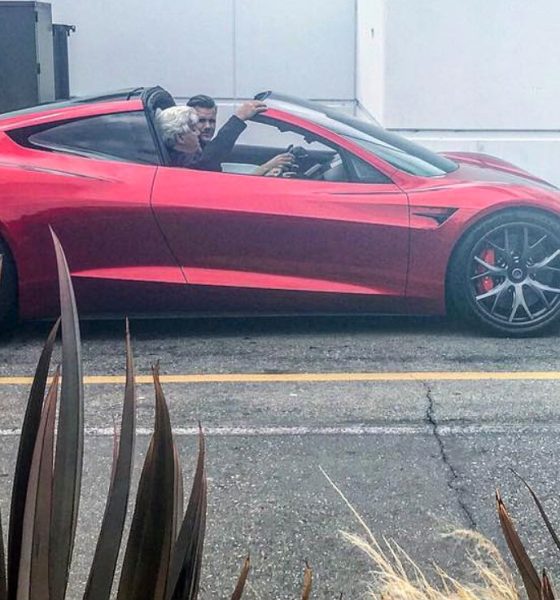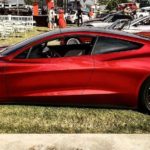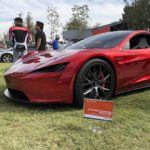

News
Elon Musk hints at Tesla Roadster’s “hovering” abilities in SpaceX package
Tesla CEO Elon Musk might not think too highly of flying cars, but hopping and hovering cars? Apparently, it may just be fair game. Oh, and you also need a next-generation Roadster with a SpaceX option package to do that. Responding with a tweet comment in a thread lauding Tesla’s impressive technology improvements over the years, the innovative tech entrepreneur teased today the next-gen Roadster may be able to hover “something like” the animated DeLorean from Back to the Future fame. Combined with his past mentions of using cold gas thrusters to enable short flight “hops” with a Roadster, one can certainly look forward to all the potential fun when first Tesla Roadster test drives begin in a presumed 2020.
The new Roadster will actually do something like this https://t.co/fIsTAYa4x8
— Elon Musk (@elonmusk) January 9, 2019
The responses to the hover comment on Twitter immediately pointed to Musk’s colorful descriptions of flying car dangers expressed in the past:
“There will be zillions of these things flying all over the place and, inevitably, somebody’s not going to service their car properly and they’re going to drop a hubcap and it’s going to guillotine somebody…And it’s going to be noisy like a hurricane,” he said at a Boring Company event in May of last year.
Of course, the entrepreneur who always gives fun a serious focus with his products is not reneging on his concerns. He simply seems to have car performance and customer satisfaction in mind. He’d also like to continue adding features to completely ensure that the next generation Roadster is a “hardcore smackdown” to gasoline cars. Part of that secret sauce is owning a rocket company that’s engineered some amazing technology of its own. Why not use what’s available?
- The next-generation Tesla Roadster at Car Classic 2018. [Credit: t35l_4/Instagram]
- The next-generation Tesla Roadster at Car Classic 2018. [Credit: Dave Kunz/Instagram]
- The next-generation Tesla Roadster at Car Classic 2018. [Credit: t35l_4/Instagram]
- Credit: Tesla
Tesla enthusiasts have been familiarized by Musk for some time now with his and the company’s plans for a “SpaceX option” package to be offered as an upgrade for the new Roadster. That package is said to include about 10 rocket thrusters “arranged seamlessly around (the) car” which would theoretically add to the vehicle’s braking ability (thrusters in front), speed acquisition (in back, to perhaps supersede “Plaid” and “Ludicrous” modes), and cornering (side thrusters). With the hovering capabilities, perhaps struggles with parallel parking will be a thing of the past for even the most hopeless at the task.
“Not saying the next gen Roadster special upgrade package *will* definitely enable it to fly short hops, but maybe …Certainly possible. Just a question of safety. Rocket tech applied to a car opens up revolutionary possibilities.” – Elon Musk, via Twitter
The SpaceX label on the Roadster option package is not just a nod to rocket thrusters, either. The high-pressure canisters used for the thruster propulsion will potentially be miniature Composite Overwrapped Pressure Vessels (COPV), the types of fuel containers used by SpaceX’s first-stage rocket boosters during re-entry and landing. Musk has also clarified that, if used, these COPV bottles would contain ultra-high pressure air that would “immediately be replenished whenever the vehicle pack power draw allowed operation of the air pump, which is most of the time.”
I’m not. Will use SpaceX cold gas thruster system with ultra high pressure air in a composite over-wrapped pressure vessel in place of the 2 rear seats.
— Elon Musk (@elonmusk) January 9, 2019
Even without space-faring options, the next generation Roadster is going to be impressive. It boasts a top speed of 250+ mph, a 0-60 mph time of 1.9 seconds, a quarter-mile time of 8.9 seconds, a 200 kWh battery pack that gives 620 miles of range, and 10,000 Nm of torque from the electric hypercar’s three electric motors. It also seats four passengers, thanks to its 2+2 seating arrangement, although 2 of those seats will be sacrificed if the SpaceX option is selected to make room for, you know, rocket thrusters – or at least their hardware.
Even better for those whose car-buying budget is in the range is the starting price point – $200-$250k. Compared to the $1 million-plus for gas guzzlers with similar performance specs, you might just say that’s a bargain. The whole deal would make great advertising, only Tesla doesn’t have to do that. Oh, well. We’ll just have to get by with Musk’s Twitter feed and the occasional company announcement, some way, some how.

Elon Musk
Elon Musk and Tesla AI Director share insights after empty driver seat Robotaxi rides
The executives’ unoccupied tests hint at the rapid progress of Tesla’s unsupervised Robotaxi efforts.

Tesla CEO Elon Musk and AI Director Ashok Elluswamy celebrated Christmas Eve by sharing personal experiences with Robotaxi vehicles that had no safety monitor or occupant in the driver’s seat. Musk described the system’s “perfect driving” around Austin, while Elluswamy posted video from the back seat, calling it “an amazing experience.”
The executives’ unoccupied tests hint at the rapid progress of Tesla’s unsupervised Robotaxi efforts.
Elon and Ashok’s firsthand Robotaxi insights
Prior to Musk and the Tesla AI Director’s posts, sightings of unmanned Teslas navigating public roads were widely shared on social media. One such vehicle was spotted in Austin, Texas, which Elon Musk acknowleged by stating that “Testing is underway with no occupants in the car.”
Based on his Christmas Eve post, Musk seemed to have tested an unmanned Tesla himself. “A Tesla with no safety monitor in the car and me sitting in the passenger seat took me all around Austin on Sunday with perfect driving,” Musk wrote in his post.
Elluswamy responded with a 2-minute video showing himself in the rear of an unmanned Tesla. The video featured the vehicle’s empty front seats, as well as its smooth handling through real-world traffic. He captioned his video with the words, “It’s an amazing experience!”
Towards Unsupervised operations
During an xAI Hackathon earlier this month, Elon Musk mentioned that Tesla owed be removing Safety Monitors from its Robotaxis in Austin in just three weeks. “Unsupervised is pretty much solved at this point. So there will be Tesla Robotaxis operating in Austin with no one in them. Not even anyone in the passenger seat in about three weeks,” he said. Musk echoed similar estimates at the 2025 Annual Shareholder Meeting and the Q3 2025 earnings call.
Considering the insights that were posted Musk and Elluswamy, it does appear that Tesla is working hard towards operating its Robotaxis with no safety monitors. This is quite impressive considering that the service was launched just earlier this year.
Elon Musk
Starlink passes 9 million active customers just weeks after hitting 8 million
The milestone highlights the accelerating growth of Starlink, which has now been adding over 20,000 new users per day.

SpaceX’s Starlink satellite internet service has continued its rapid global expansion, surpassing 9 million active customers just weeks after crossing the 8 million mark.
The milestone highlights the accelerating growth of Starlink, which has now been adding over 20,000 new users per day.
9 million customers
In a post on X, SpaceX stated that Starlink now serves over 9 million active users across 155 countries, territories, and markets. The company reached 8 million customers in early November, meaning it added roughly 1 million subscribers in under seven weeks, or about 21,275 new users on average per day.
“Starlink is connecting more than 9M active customers with high-speed internet across 155 countries, territories, and many other markets,” Starlink wrote in a post on its official X account. SpaceX President Gwynne Shotwell also celebrated the milestone on X. “A huge thank you to all of our customers and congrats to the Starlink team for such an incredible product,” she wrote.
That growth rate reflects both rising demand for broadband in underserved regions and Starlink’s expanding satellite constellation, which now includes more than 9,000 low-Earth-orbit satellites designed to deliver high-speed, low-latency internet worldwide.
Starlink’s momentum
Starlink’s momentum has been building up. SpaceX reported 4.6 million Starlink customers in December 2024, followed by 7 million by August 2025, and 8 million customers in November. Independent data also suggests Starlink usage is rising sharply, with Cloudflare reporting that global web traffic from Starlink users more than doubled in 2025, as noted in an Insider report.
Starlink’s momentum is increasingly tied to SpaceX’s broader financial outlook. Elon Musk has said the satellite network is “by far” the company’s largest revenue driver, and reports suggest SpaceX may be positioning itself for an initial public offering as soon as next year, with valuations estimated as high as $1.5 trillion. Musk has also suggested in the past that Starlink could have its own IPO in the future.
News
NVIDIA Director of Robotics: Tesla FSD v14 is the first AI to pass the “Physical Turing Test”
After testing FSD v14, Fan stated that his experience with FSD felt magical at first, but it soon started to feel like a routine.

NVIDIA Director of Robotics Jim Fan has praised Tesla’s Full Self-Driving (Supervised) v14 as the first AI to pass what he described as a “Physical Turing Test.”
After testing FSD v14, Fan stated that his experience with FSD felt magical at first, but it soon started to feel like a routine. And just like smartphones today, removing it now would “actively hurt.”
Jim Fan’s hands-on FSD v14 impressions
Fan, a leading researcher in embodied AI who is currently solving Physical AI at NVIDIA and spearheading the company’s Project GR00T initiative, noted that he actually was late to the Tesla game. He was, however, one of the first to try out FSD v14.
“I was very late to own a Tesla but among the earliest to try out FSD v14. It’s perhaps the first time I experience an AI that passes the Physical Turing Test: after a long day at work, you press a button, lay back, and couldn’t tell if a neural net or a human drove you home,” Fan wrote in a post on X.
Fan added: “Despite knowing exactly how robot learning works, I still find it magical watching the steering wheel turn by itself. First it feels surreal, next it becomes routine. Then, like the smartphone, taking it away actively hurts. This is how humanity gets rewired and glued to god-like technologies.”
The Physical Turing Test
The original Turing Test was conceived by Alan Turing in 1950, and it was aimed at determining if a machine could exhibit behavior that is equivalent to or indistinguishable from a human. By focusing on text-based conversations, the original Turing Test set a high bar for natural language processing and machine learning.
This test has been passed by today’s large language models. However, the capability to converse in a humanlike manner is a completely different challenge from performing real-world problem-solving or physical interactions. Thus, Fan introduced the Physical Turing Test, which challenges AI systems to demonstrate intelligence through physical actions.
Based on Fan’s comments, Tesla has demonstrated these intelligent physical actions with FSD v14. Elon Musk agreed with the NVIDIA executive, stating in a post on X that with FSD v14, “you can sense the sentience maturing.” Musk also praised Tesla AI, calling it the best “real-world AI” today.














